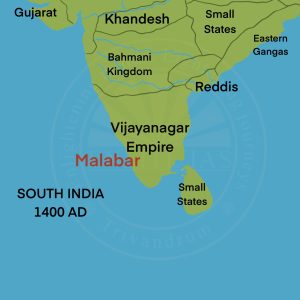Vijayanagara Empire: (1336-1646) CE
- The kingdom of Vijayanagara was established by Harihara and Bukka.
- After functioning as feudatories under the Warangal Kakatiyas, they were appointed ministers in the Kampili Kingdom (present-day Karnataka).
- Following the fall of Kampili, the two brothers were imprisoned, converted to Islam, and sent to work for Muhammad bin Tughlaq.
- But soon after, both Harihara and Bukka abandoned the new faith and their new master.
- Sage Vidyaranya readmitted Harihara and Bukka to Hinduism in the 14th century.
- Harihara Bukka formed a new Empire with its capital in Vijayanagar.

- There were four dynasties: Sangama, Saluva, Tuluva, and Aravidu which ruled over Vijayanagara from 1336 to 1646 CE.
Sangama Dynasty (1336-1485)
- First dynasty of Vijayanagara
Important Rulers
Harihara (1336 – 1356 CE)
- Harihara, along with his brother Bukka, established the Vijayanagar Empire.
- During his first 20 years of power, he dominated the country south of the Tungabhadra.
- He earned the title “master of the eastern and western seas“, ‘Karnataka Vidya Vilas,’ ‘Arirayavibhada,’ or ‘fire to enemy kings,’ and ‘Bhashegetappuvarayaraganda.
Bukka (1356 – 1377)
- Defeated the Sultan of Madurai and extended the territory into the south to Rameswaram.
Deva Raya – I (1405 – 1422)
- Niccolo de Conti, Ferishta, Nuniz give accounts of his kingdom.
- He was a secular ruler.
Deva Raya – II (1422 – 46)
- Accepted title “Gajabeteegara”
- Built Hazare Rama temple at Hampi.
- Travelers Abdur Razzak and Nicolo de Conti give an account of his rule.
Saluva Dynasty (1485 – 1505 CE)
- Narasimha established the Saluva dynasty, which became the empire’s second dynasty after the Sangama dynasty.
- It ruled between 1485 and 1505 CE. They controlled nearly all of South India.
- Vasco da Gama visited during the Saluva period.
Tuluva Dynasty (1490 CE-1570 CE)
- The third among the Vijayanagara Empires
Important Rulers
Krishna Deva Raya (1509 – 1529 CE)
- Known as –
- Karnataka Ratna Simhasanadeeshwara (“Lord of the Jewelled Throne of Karnataka”)
- Yavana Rajya Pratisthapanacharya (“Establishment of the King to Throne”),
- Andhra Bhoja (“Scholar of Andhra”),
- Andra Pitamaha
- Gaubrahmana Pratipalaka (“Protector of Brahmins and Cows”) and
- Mooru Rayara Ganda ( “Lord of Three Kings”).
- Established Matrimonial Alliance with Kalinga king Prataparudra
- He waged battle against the Bahamani kingdom and kept them under control.
- Mohammad Shah was liberated, and he acquired the title “Yavanarjya Prathishtapanacharya”.
- His dominion stretched from the river Krishna in the north to the Cauvery in the south, and from the Arabian Sea in the west to the Bay of Bengal in the east.
- He had a good relationship with the Portuguese. Utilized Portuguese expertise to improve the water supply to Vijayanagara City.
- Made a significant contribution to art architecture and literature –
- He wrote, “Amuktamalyada” (a Telugu book about politics), Satyavadu Parinaya, and “Jambavati Kalyanam” (a Sanskrit play).
- Krishna Deva Raya built the Hazara Rama and Vittalaswami temples.
- Patronized intellectuals and poets of Telugu, Kannada, Sanskrit, and Tamil.
- In honor of his queen Nagaladevi, he founded the city of Nagalapuram.
- He had eight great academics known as ‘Ashtadiggajas’ in his royal court. They were:-
- Allasani Peddanna – the author of Manucharitram, he was also known as Andhra Kavitapitamaha
- Nandi Thimmana – the author of Parijathapaharanam
- Madayagari Mallana
- Dhurjati
- Ayyalaraju Ramabhadrudu
- Pingali Surana
- RamarajaBhushana
- Tenali Ramakrishna
Administration
- The king had complete control of administrative, judicial, and legislative issues.
- The succession to the throne was hereditary.
- Administrative units are classified as Mandalams, Nadus, Sthalas, and Gramas.
- Mandaleshwar, or Nayaka, was the governor of Mandalam.
- He had great authority, including the ability to produce coins in minor denominations and impose new taxes or refund existing ones.
- Income sources include land revenue, tributes and gifts from vassals and feudal leaders, customs duties at ports, and taxes on different professions.
- The army was composed of cavalry, infantry, artillery, and elephants.
- Nayankar System – The army’s highest officers were known as Nayaks or Poligars.
- In exchange for their services, they were handed territory known as Amaram.
- Manyams were tax-free territories.
Art and Architecture
- Vijayanagara architecture was distinguished by the construction of tall Raya Gopurams or gates, as well as the Kalyanamandapam with carved pillars on temple grounds.
- The sculptures on the pillars were designed with specific characteristics.
- Horses were the most prevalent animals found in these pillars.
- The most notable temples created were the Vittalaswamy and Hazara Ramaswamy temples, as well as the Stone Chariot in Hampi.
- Varadharaja and Ekambaranatha temples at Kanchipuram.
- Various languages like Sanskrit, Telugu, Kannada, and Tamil prospered in the territories.
- The Vijayanagar period is notable for the origins of Carnatic music under Purandhar Das.
- Bharatanatyam and Yakshagana were renowned temple-themed dance dramas.
- Bronze Sculptures – Sculptural art in Vijayanagar follows the Chola style. The graphics have more movement and fluidity in the Vijayanagara period.
Disputes faced by Vijanagara
- The Vijayanagar Empire and the Bahamani dynasty were in continual struggle for Raichur doab (fertile region between Krishna and Tungabhadra), Tungabhadra doab (fertile parts of the Krishna-Godavari delta), and Marathwada.
- In the south, its principal competitors were the Sultans of Madurai.
Reasons for Decline
- During Rama Raya’s reign, the united armies of Bijapur, Ahmednagar, Golkonda, and Bidar defeated him at the Battle of Talikotta in 1565, signaling the end of the Vijayanagar Empire.
- The last emperor of Vijayanagara was Sri Ranga III.
